Strategic Human Resource Management Report: Marks & Spencer HRM325
VerifiedAdded on 2020/07/22
|15
|4322
|36
Report
AI Summary
This report provides a comprehensive analysis of strategic human resource management (SHRM), focusing on its application within Marks & Spencer. The report begins by establishing the relationship between business strategy and human resource strategy, emphasizing the importance of vertical alignment and horizontal integration within the organization. It then delves into the theoretical basis and models of SHRM, including corporate strategy, business strategy, and HRIS, as well as resource-based view theory and best practice theory. The report examines HR practices related to performance management and reward systems, including performance appraisal, financial and non-financial rewards, and the contributions of both employers and employees to performance. Finally, the report addresses the design and redesign of performance management systems, highlighting key considerations for effective implementation. The report aims to provide business leaders with knowledge and understanding of SHRM to shape and structure debate and to facilitate their decision making when developing an effective HRM strategy.
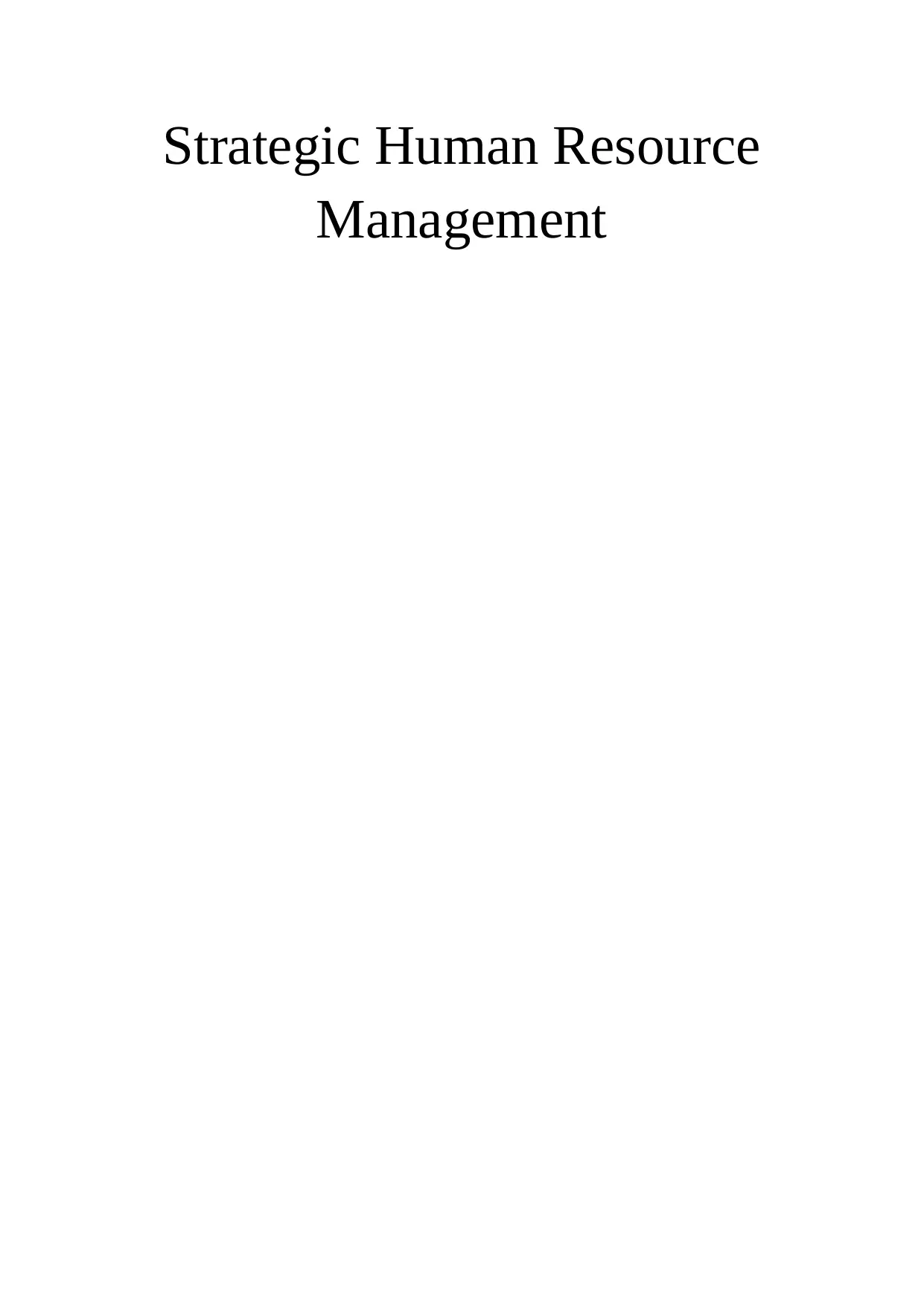
Strategic Human Resource
Management
Management
Paraphrase This Document
Need a fresh take? Get an instant paraphrase of this document with our AI Paraphraser
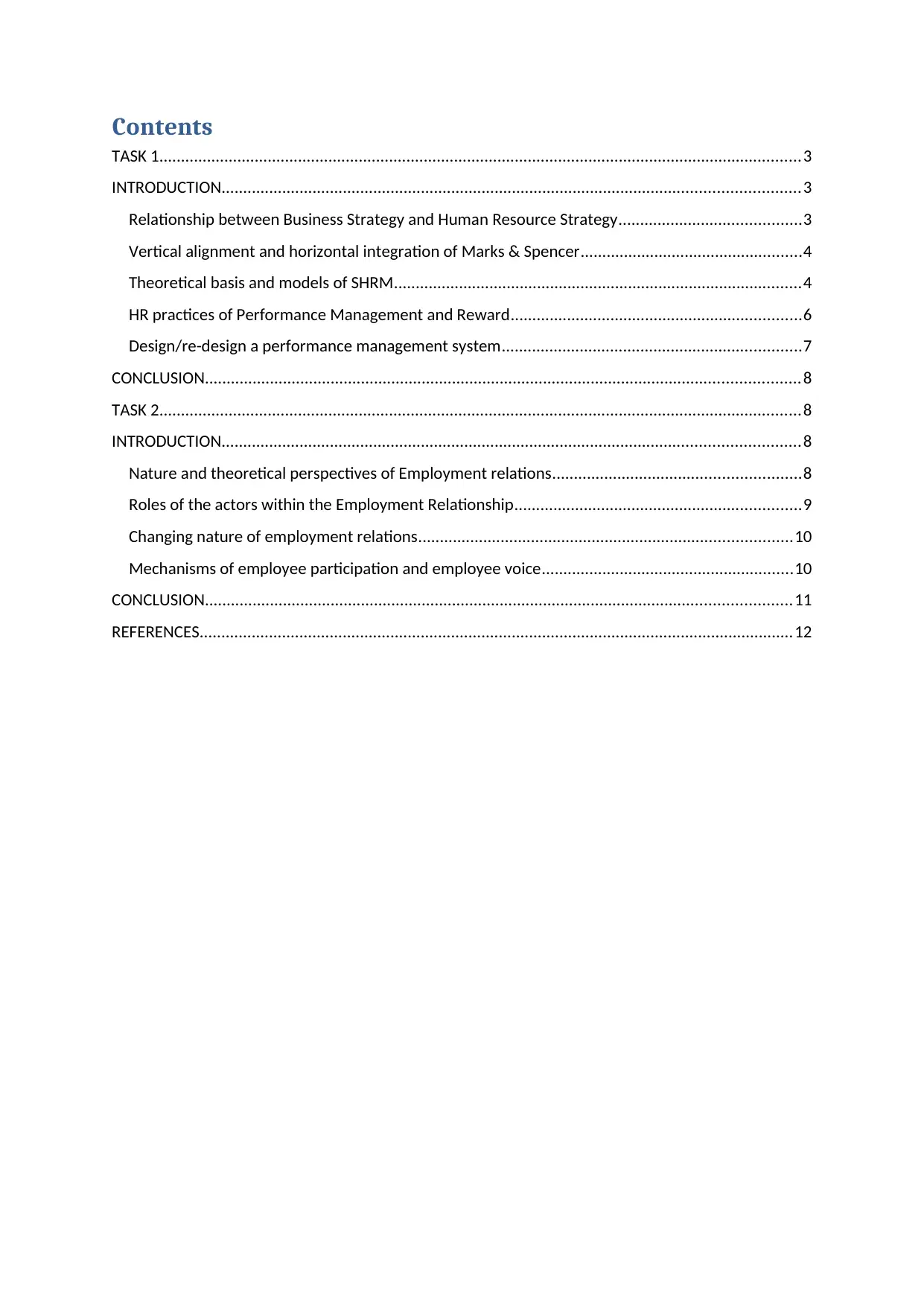
Contents
TASK 1....................................................................................................................................................3
INTRODUCTION.....................................................................................................................................3
Relationship between Business Strategy and Human Resource Strategy..........................................3
Vertical alignment and horizontal integration of Marks & Spencer...................................................4
Theoretical basis and models of SHRM..............................................................................................4
HR practices of Performance Management and Reward...................................................................6
Design/re-design a performance management system.....................................................................7
CONCLUSION.........................................................................................................................................8
TASK 2....................................................................................................................................................8
INTRODUCTION.....................................................................................................................................8
Nature and theoretical perspectives of Employment relations.........................................................8
Roles of the actors within the Employment Relationship..................................................................9
Changing nature of employment relations......................................................................................10
Mechanisms of employee participation and employee voice..........................................................10
CONCLUSION.......................................................................................................................................11
REFERENCES.........................................................................................................................................12
TASK 1....................................................................................................................................................3
INTRODUCTION.....................................................................................................................................3
Relationship between Business Strategy and Human Resource Strategy..........................................3
Vertical alignment and horizontal integration of Marks & Spencer...................................................4
Theoretical basis and models of SHRM..............................................................................................4
HR practices of Performance Management and Reward...................................................................6
Design/re-design a performance management system.....................................................................7
CONCLUSION.........................................................................................................................................8
TASK 2....................................................................................................................................................8
INTRODUCTION.....................................................................................................................................8
Nature and theoretical perspectives of Employment relations.........................................................8
Roles of the actors within the Employment Relationship..................................................................9
Changing nature of employment relations......................................................................................10
Mechanisms of employee participation and employee voice..........................................................10
CONCLUSION.......................................................................................................................................11
REFERENCES.........................................................................................................................................12
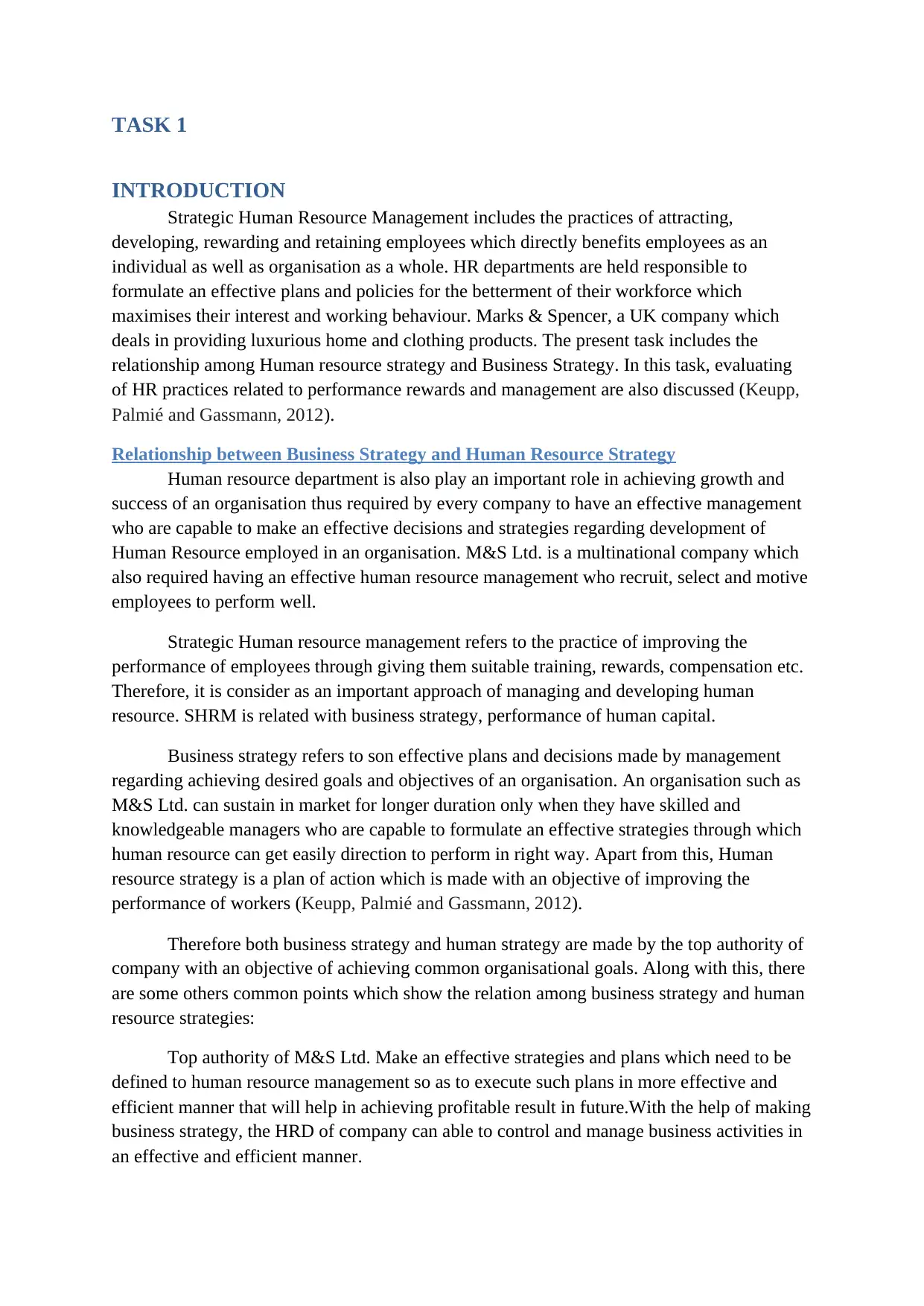
TASK 1
INTRODUCTION
Strategic Human Resource Management includes the practices of attracting,
developing, rewarding and retaining employees which directly benefits employees as an
individual as well as organisation as a whole. HR departments are held responsible to
formulate an effective plans and policies for the betterment of their workforce which
maximises their interest and working behaviour. Marks & Spencer, a UK company which
deals in providing luxurious home and clothing products. The present task includes the
relationship among Human resource strategy and Business Strategy. In this task, evaluating
of HR practices related to performance rewards and management are also discussed (Keupp,
Palmié and Gassmann, 2012).
Relationship between Business Strategy and Human Resource Strategy
Human resource department is also play an important role in achieving growth and
success of an organisation thus required by every company to have an effective management
who are capable to make an effective decisions and strategies regarding development of
Human Resource employed in an organisation. M&S Ltd. is a multinational company which
also required having an effective human resource management who recruit, select and motive
employees to perform well.
Strategic Human resource management refers to the practice of improving the
performance of employees through giving them suitable training, rewards, compensation etc.
Therefore, it is consider as an important approach of managing and developing human
resource. SHRM is related with business strategy, performance of human capital.
Business strategy refers to son effective plans and decisions made by management
regarding achieving desired goals and objectives of an organisation. An organisation such as
M&S Ltd. can sustain in market for longer duration only when they have skilled and
knowledgeable managers who are capable to formulate an effective strategies through which
human resource can get easily direction to perform in right way. Apart from this, Human
resource strategy is a plan of action which is made with an objective of improving the
performance of workers (Keupp, Palmié and Gassmann, 2012).
Therefore both business strategy and human strategy are made by the top authority of
company with an objective of achieving common organisational goals. Along with this, there
are some others common points which show the relation among business strategy and human
resource strategies:
Top authority of M&S Ltd. Make an effective strategies and plans which need to be
defined to human resource management so as to execute such plans in more effective and
efficient manner that will help in achieving profitable result in future.With the help of making
business strategy, the HRD of company can able to control and manage business activities in
an effective and efficient manner.
INTRODUCTION
Strategic Human Resource Management includes the practices of attracting,
developing, rewarding and retaining employees which directly benefits employees as an
individual as well as organisation as a whole. HR departments are held responsible to
formulate an effective plans and policies for the betterment of their workforce which
maximises their interest and working behaviour. Marks & Spencer, a UK company which
deals in providing luxurious home and clothing products. The present task includes the
relationship among Human resource strategy and Business Strategy. In this task, evaluating
of HR practices related to performance rewards and management are also discussed (Keupp,
Palmié and Gassmann, 2012).
Relationship between Business Strategy and Human Resource Strategy
Human resource department is also play an important role in achieving growth and
success of an organisation thus required by every company to have an effective management
who are capable to make an effective decisions and strategies regarding development of
Human Resource employed in an organisation. M&S Ltd. is a multinational company which
also required having an effective human resource management who recruit, select and motive
employees to perform well.
Strategic Human resource management refers to the practice of improving the
performance of employees through giving them suitable training, rewards, compensation etc.
Therefore, it is consider as an important approach of managing and developing human
resource. SHRM is related with business strategy, performance of human capital.
Business strategy refers to son effective plans and decisions made by management
regarding achieving desired goals and objectives of an organisation. An organisation such as
M&S Ltd. can sustain in market for longer duration only when they have skilled and
knowledgeable managers who are capable to formulate an effective strategies through which
human resource can get easily direction to perform in right way. Apart from this, Human
resource strategy is a plan of action which is made with an objective of improving the
performance of workers (Keupp, Palmié and Gassmann, 2012).
Therefore both business strategy and human strategy are made by the top authority of
company with an objective of achieving common organisational goals. Along with this, there
are some others common points which show the relation among business strategy and human
resource strategies:
Top authority of M&S Ltd. Make an effective strategies and plans which need to be
defined to human resource management so as to execute such plans in more effective and
efficient manner that will help in achieving profitable result in future.With the help of making
business strategy, the HRD of company can able to control and manage business activities in
an effective and efficient manner.
⊘ This is a preview!⊘
Do you want full access?
Subscribe today to unlock all pages.

Trusted by 1+ million students worldwide
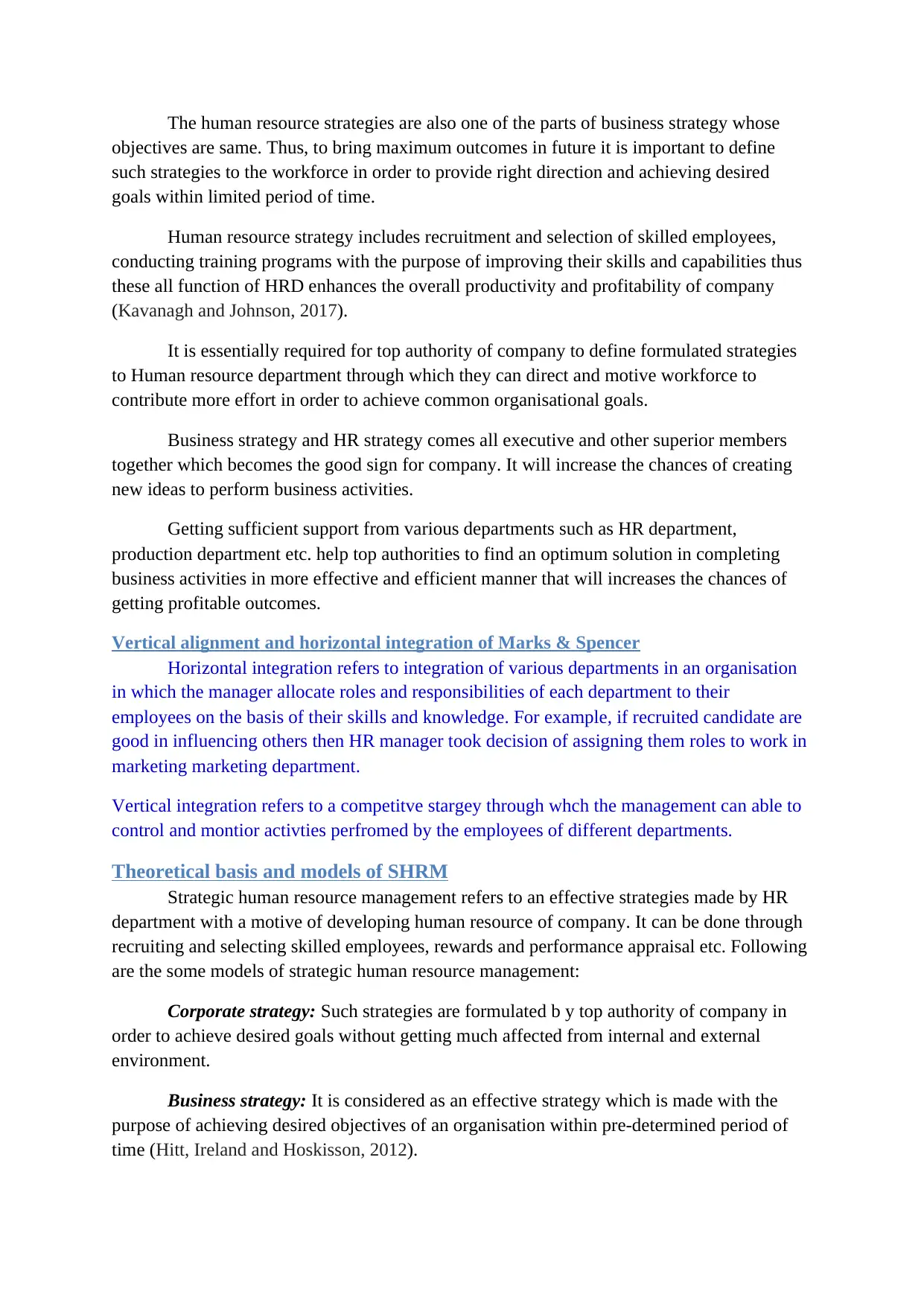
The human resource strategies are also one of the parts of business strategy whose
objectives are same. Thus, to bring maximum outcomes in future it is important to define
such strategies to the workforce in order to provide right direction and achieving desired
goals within limited period of time.
Human resource strategy includes recruitment and selection of skilled employees,
conducting training programs with the purpose of improving their skills and capabilities thus
these all function of HRD enhances the overall productivity and profitability of company
(Kavanagh and Johnson, 2017).
It is essentially required for top authority of company to define formulated strategies
to Human resource department through which they can direct and motive workforce to
contribute more effort in order to achieve common organisational goals.
Business strategy and HR strategy comes all executive and other superior members
together which becomes the good sign for company. It will increase the chances of creating
new ideas to perform business activities.
Getting sufficient support from various departments such as HR department,
production department etc. help top authorities to find an optimum solution in completing
business activities in more effective and efficient manner that will increases the chances of
getting profitable outcomes.
Vertical alignment and horizontal integration of Marks & Spencer
Horizontal integration refers to integration of various departments in an organisation
in which the manager allocate roles and responsibilities of each department to their
employees on the basis of their skills and knowledge. For example, if recruited candidate are
good in influencing others then HR manager took decision of assigning them roles to work in
marketing marketing department.
Vertical integration refers to a competitve stargey through whch the management can able to
control and montior activties perfromed by the employees of different departments.
Theoretical basis and models of SHRM
Strategic human resource management refers to an effective strategies made by HR
department with a motive of developing human resource of company. It can be done through
recruiting and selecting skilled employees, rewards and performance appraisal etc. Following
are the some models of strategic human resource management:
Corporate strategy: Such strategies are formulated b y top authority of company in
order to achieve desired goals without getting much affected from internal and external
environment.
Business strategy: It is considered as an effective strategy which is made with the
purpose of achieving desired objectives of an organisation within pre-determined period of
time (Hitt, Ireland and Hoskisson, 2012).
objectives are same. Thus, to bring maximum outcomes in future it is important to define
such strategies to the workforce in order to provide right direction and achieving desired
goals within limited period of time.
Human resource strategy includes recruitment and selection of skilled employees,
conducting training programs with the purpose of improving their skills and capabilities thus
these all function of HRD enhances the overall productivity and profitability of company
(Kavanagh and Johnson, 2017).
It is essentially required for top authority of company to define formulated strategies
to Human resource department through which they can direct and motive workforce to
contribute more effort in order to achieve common organisational goals.
Business strategy and HR strategy comes all executive and other superior members
together which becomes the good sign for company. It will increase the chances of creating
new ideas to perform business activities.
Getting sufficient support from various departments such as HR department,
production department etc. help top authorities to find an optimum solution in completing
business activities in more effective and efficient manner that will increases the chances of
getting profitable outcomes.
Vertical alignment and horizontal integration of Marks & Spencer
Horizontal integration refers to integration of various departments in an organisation
in which the manager allocate roles and responsibilities of each department to their
employees on the basis of their skills and knowledge. For example, if recruited candidate are
good in influencing others then HR manager took decision of assigning them roles to work in
marketing marketing department.
Vertical integration refers to a competitve stargey through whch the management can able to
control and montior activties perfromed by the employees of different departments.
Theoretical basis and models of SHRM
Strategic human resource management refers to an effective strategies made by HR
department with a motive of developing human resource of company. It can be done through
recruiting and selecting skilled employees, rewards and performance appraisal etc. Following
are the some models of strategic human resource management:
Corporate strategy: Such strategies are formulated b y top authority of company in
order to achieve desired goals without getting much affected from internal and external
environment.
Business strategy: It is considered as an effective strategy which is made with the
purpose of achieving desired objectives of an organisation within pre-determined period of
time (Hitt, Ireland and Hoskisson, 2012).
Paraphrase This Document
Need a fresh take? Get an instant paraphrase of this document with our AI Paraphraser
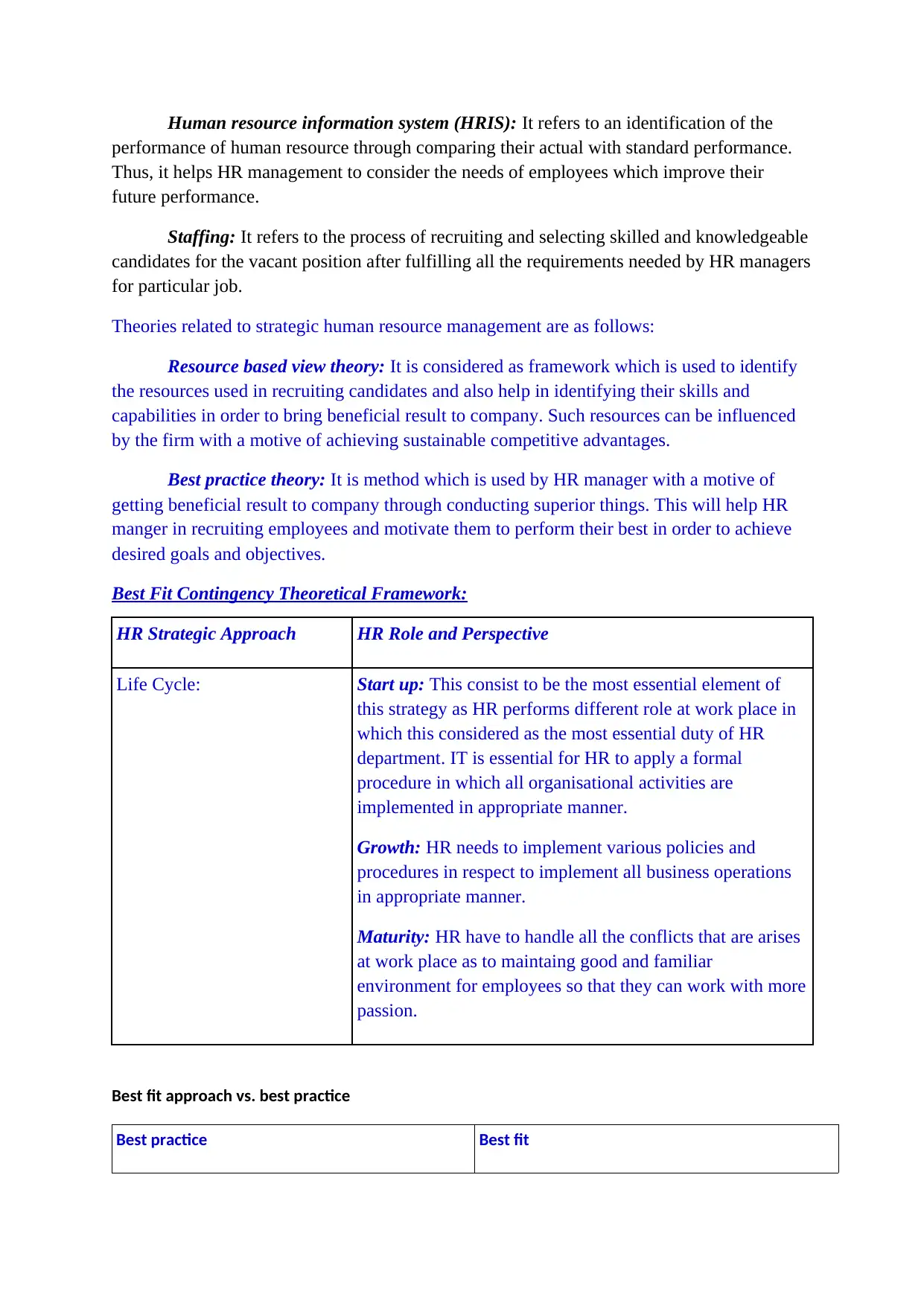
Human resource information system (HRIS): It refers to an identification of the
performance of human resource through comparing their actual with standard performance.
Thus, it helps HR management to consider the needs of employees which improve their
future performance.
Staffing: It refers to the process of recruiting and selecting skilled and knowledgeable
candidates for the vacant position after fulfilling all the requirements needed by HR managers
for particular job.
Theories related to strategic human resource management are as follows:
Resource based view theory: It is considered as framework which is used to identify
the resources used in recruiting candidates and also help in identifying their skills and
capabilities in order to bring beneficial result to company. Such resources can be influenced
by the firm with a motive of achieving sustainable competitive advantages.
Best practice theory: It is method which is used by HR manager with a motive of
getting beneficial result to company through conducting superior things. This will help HR
manger in recruiting employees and motivate them to perform their best in order to achieve
desired goals and objectives.
Best Fit Contingency Theoretical Framework:
HR Strategic Approach HR Role and Perspective
Life Cycle: Start up: This consist to be the most essential element of
this strategy as HR performs different role at work place in
which this considered as the most essential duty of HR
department. IT is essential for HR to apply a formal
procedure in which all organisational activities are
implemented in appropriate manner.
Growth: HR needs to implement various policies and
procedures in respect to implement all business operations
in appropriate manner.
Maturity: HR have to handle all the conflicts that are arises
at work place as to maintaing good and familiar
environment for employees so that they can work with more
passion.
Best fit approach vs. best practice
Best practice Best fit
performance of human resource through comparing their actual with standard performance.
Thus, it helps HR management to consider the needs of employees which improve their
future performance.
Staffing: It refers to the process of recruiting and selecting skilled and knowledgeable
candidates for the vacant position after fulfilling all the requirements needed by HR managers
for particular job.
Theories related to strategic human resource management are as follows:
Resource based view theory: It is considered as framework which is used to identify
the resources used in recruiting candidates and also help in identifying their skills and
capabilities in order to bring beneficial result to company. Such resources can be influenced
by the firm with a motive of achieving sustainable competitive advantages.
Best practice theory: It is method which is used by HR manager with a motive of
getting beneficial result to company through conducting superior things. This will help HR
manger in recruiting employees and motivate them to perform their best in order to achieve
desired goals and objectives.
Best Fit Contingency Theoretical Framework:
HR Strategic Approach HR Role and Perspective
Life Cycle: Start up: This consist to be the most essential element of
this strategy as HR performs different role at work place in
which this considered as the most essential duty of HR
department. IT is essential for HR to apply a formal
procedure in which all organisational activities are
implemented in appropriate manner.
Growth: HR needs to implement various policies and
procedures in respect to implement all business operations
in appropriate manner.
Maturity: HR have to handle all the conflicts that are arises
at work place as to maintaing good and familiar
environment for employees so that they can work with more
passion.
Best fit approach vs. best practice
Best practice Best fit
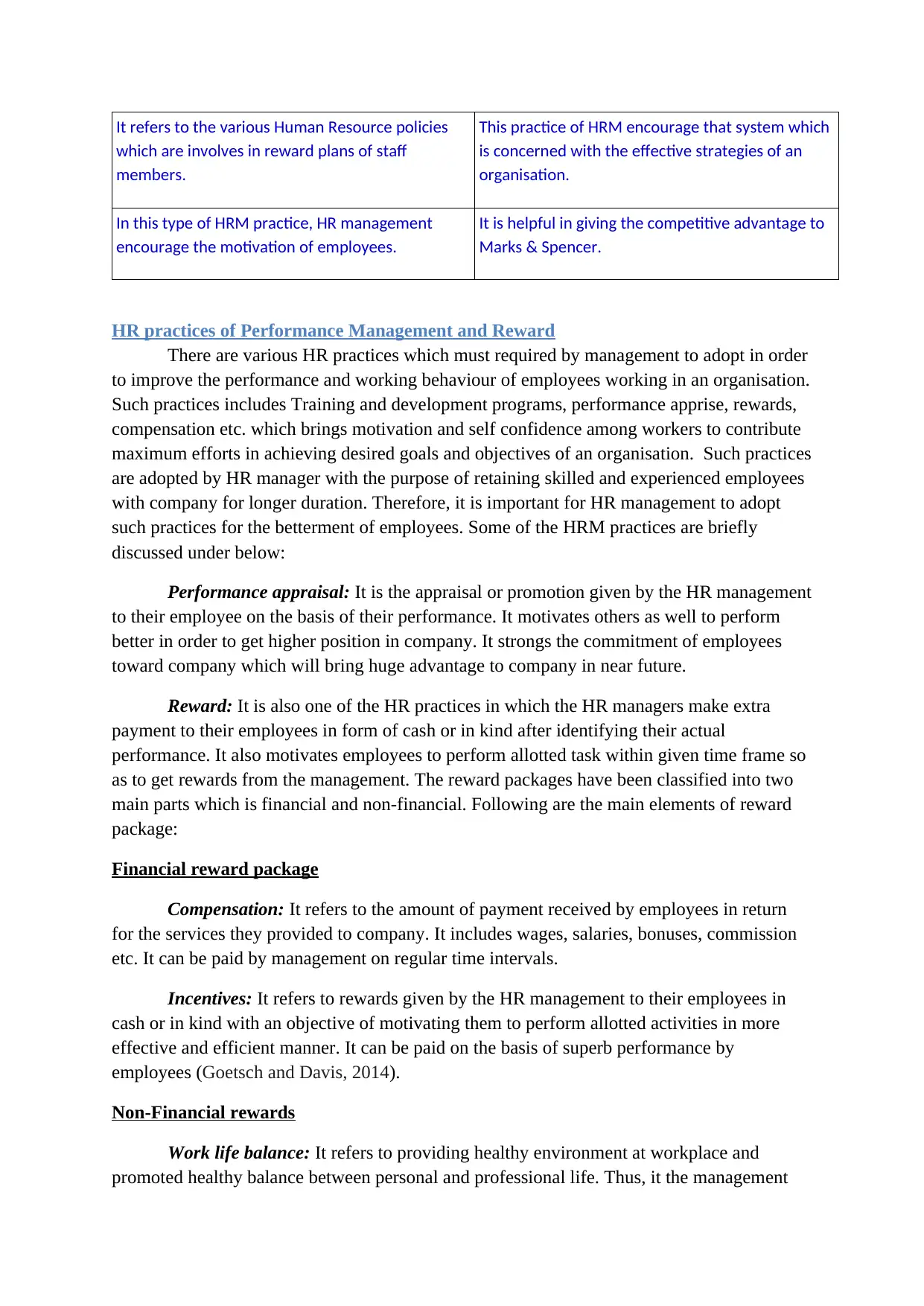
It refers to the various Human Resource policies
which are involves in reward plans of staff
members.
This practice of HRM encourage that system which
is concerned with the effective strategies of an
organisation.
In this type of HRM practice, HR management
encourage the motivation of employees.
It is helpful in giving the competitive advantage to
Marks & Spencer.
HR practices of Performance Management and Reward
There are various HR practices which must required by management to adopt in order
to improve the performance and working behaviour of employees working in an organisation.
Such practices includes Training and development programs, performance apprise, rewards,
compensation etc. which brings motivation and self confidence among workers to contribute
maximum efforts in achieving desired goals and objectives of an organisation. Such practices
are adopted by HR manager with the purpose of retaining skilled and experienced employees
with company for longer duration. Therefore, it is important for HR management to adopt
such practices for the betterment of employees. Some of the HRM practices are briefly
discussed under below:
Performance appraisal: It is the appraisal or promotion given by the HR management
to their employee on the basis of their performance. It motivates others as well to perform
better in order to get higher position in company. It strongs the commitment of employees
toward company which will bring huge advantage to company in near future.
Reward: It is also one of the HR practices in which the HR managers make extra
payment to their employees in form of cash or in kind after identifying their actual
performance. It also motivates employees to perform allotted task within given time frame so
as to get rewards from the management. The reward packages have been classified into two
main parts which is financial and non-financial. Following are the main elements of reward
package:
Financial reward package
Compensation: It refers to the amount of payment received by employees in return
for the services they provided to company. It includes wages, salaries, bonuses, commission
etc. It can be paid by management on regular time intervals.
Incentives: It refers to rewards given by the HR management to their employees in
cash or in kind with an objective of motivating them to perform allotted activities in more
effective and efficient manner. It can be paid on the basis of superb performance by
employees (Goetsch and Davis, 2014).
Non-Financial rewards
Work life balance: It refers to providing healthy environment at workplace and
promoted healthy balance between personal and professional life. Thus, it the management
which are involves in reward plans of staff
members.
This practice of HRM encourage that system which
is concerned with the effective strategies of an
organisation.
In this type of HRM practice, HR management
encourage the motivation of employees.
It is helpful in giving the competitive advantage to
Marks & Spencer.
HR practices of Performance Management and Reward
There are various HR practices which must required by management to adopt in order
to improve the performance and working behaviour of employees working in an organisation.
Such practices includes Training and development programs, performance apprise, rewards,
compensation etc. which brings motivation and self confidence among workers to contribute
maximum efforts in achieving desired goals and objectives of an organisation. Such practices
are adopted by HR manager with the purpose of retaining skilled and experienced employees
with company for longer duration. Therefore, it is important for HR management to adopt
such practices for the betterment of employees. Some of the HRM practices are briefly
discussed under below:
Performance appraisal: It is the appraisal or promotion given by the HR management
to their employee on the basis of their performance. It motivates others as well to perform
better in order to get higher position in company. It strongs the commitment of employees
toward company which will bring huge advantage to company in near future.
Reward: It is also one of the HR practices in which the HR managers make extra
payment to their employees in form of cash or in kind after identifying their actual
performance. It also motivates employees to perform allotted task within given time frame so
as to get rewards from the management. The reward packages have been classified into two
main parts which is financial and non-financial. Following are the main elements of reward
package:
Financial reward package
Compensation: It refers to the amount of payment received by employees in return
for the services they provided to company. It includes wages, salaries, bonuses, commission
etc. It can be paid by management on regular time intervals.
Incentives: It refers to rewards given by the HR management to their employees in
cash or in kind with an objective of motivating them to perform allotted activities in more
effective and efficient manner. It can be paid on the basis of superb performance by
employees (Goetsch and Davis, 2014).
Non-Financial rewards
Work life balance: It refers to providing healthy environment at workplace and
promoted healthy balance between personal and professional life. Thus, it the management
⊘ This is a preview!⊘
Do you want full access?
Subscribe today to unlock all pages.

Trusted by 1+ million students worldwide
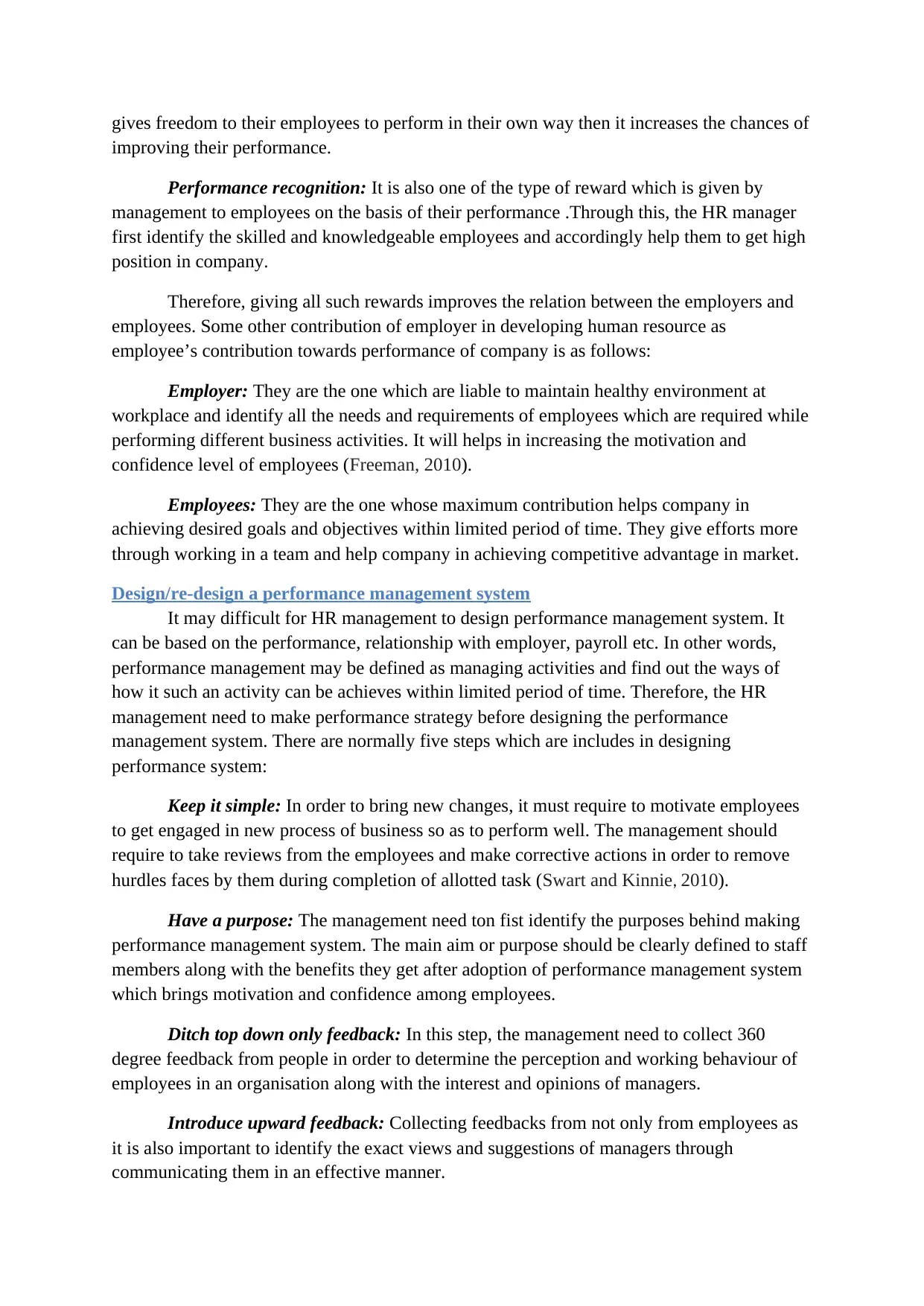
gives freedom to their employees to perform in their own way then it increases the chances of
improving their performance.
Performance recognition: It is also one of the type of reward which is given by
management to employees on the basis of their performance .Through this, the HR manager
first identify the skilled and knowledgeable employees and accordingly help them to get high
position in company.
Therefore, giving all such rewards improves the relation between the employers and
employees. Some other contribution of employer in developing human resource as
employee’s contribution towards performance of company is as follows:
Employer: They are the one which are liable to maintain healthy environment at
workplace and identify all the needs and requirements of employees which are required while
performing different business activities. It will helps in increasing the motivation and
confidence level of employees (Freeman, 2010).
Employees: They are the one whose maximum contribution helps company in
achieving desired goals and objectives within limited period of time. They give efforts more
through working in a team and help company in achieving competitive advantage in market.
Design/re-design a performance management system
It may difficult for HR management to design performance management system. It
can be based on the performance, relationship with employer, payroll etc. In other words,
performance management may be defined as managing activities and find out the ways of
how it such an activity can be achieves within limited period of time. Therefore, the HR
management need to make performance strategy before designing the performance
management system. There are normally five steps which are includes in designing
performance system:
Keep it simple: In order to bring new changes, it must require to motivate employees
to get engaged in new process of business so as to perform well. The management should
require to take reviews from the employees and make corrective actions in order to remove
hurdles faces by them during completion of allotted task (Swart and Kinnie, 2010).
Have a purpose: The management need ton fist identify the purposes behind making
performance management system. The main aim or purpose should be clearly defined to staff
members along with the benefits they get after adoption of performance management system
which brings motivation and confidence among employees.
Ditch top down only feedback: In this step, the management need to collect 360
degree feedback from people in order to determine the perception and working behaviour of
employees in an organisation along with the interest and opinions of managers.
Introduce upward feedback: Collecting feedbacks from not only from employees as
it is also important to identify the exact views and suggestions of managers through
communicating them in an effective manner.
improving their performance.
Performance recognition: It is also one of the type of reward which is given by
management to employees on the basis of their performance .Through this, the HR manager
first identify the skilled and knowledgeable employees and accordingly help them to get high
position in company.
Therefore, giving all such rewards improves the relation between the employers and
employees. Some other contribution of employer in developing human resource as
employee’s contribution towards performance of company is as follows:
Employer: They are the one which are liable to maintain healthy environment at
workplace and identify all the needs and requirements of employees which are required while
performing different business activities. It will helps in increasing the motivation and
confidence level of employees (Freeman, 2010).
Employees: They are the one whose maximum contribution helps company in
achieving desired goals and objectives within limited period of time. They give efforts more
through working in a team and help company in achieving competitive advantage in market.
Design/re-design a performance management system
It may difficult for HR management to design performance management system. It
can be based on the performance, relationship with employer, payroll etc. In other words,
performance management may be defined as managing activities and find out the ways of
how it such an activity can be achieves within limited period of time. Therefore, the HR
management need to make performance strategy before designing the performance
management system. There are normally five steps which are includes in designing
performance system:
Keep it simple: In order to bring new changes, it must require to motivate employees
to get engaged in new process of business so as to perform well. The management should
require to take reviews from the employees and make corrective actions in order to remove
hurdles faces by them during completion of allotted task (Swart and Kinnie, 2010).
Have a purpose: The management need ton fist identify the purposes behind making
performance management system. The main aim or purpose should be clearly defined to staff
members along with the benefits they get after adoption of performance management system
which brings motivation and confidence among employees.
Ditch top down only feedback: In this step, the management need to collect 360
degree feedback from people in order to determine the perception and working behaviour of
employees in an organisation along with the interest and opinions of managers.
Introduce upward feedback: Collecting feedbacks from not only from employees as
it is also important to identify the exact views and suggestions of managers through
communicating them in an effective manner.
Paraphrase This Document
Need a fresh take? Get an instant paraphrase of this document with our AI Paraphraser
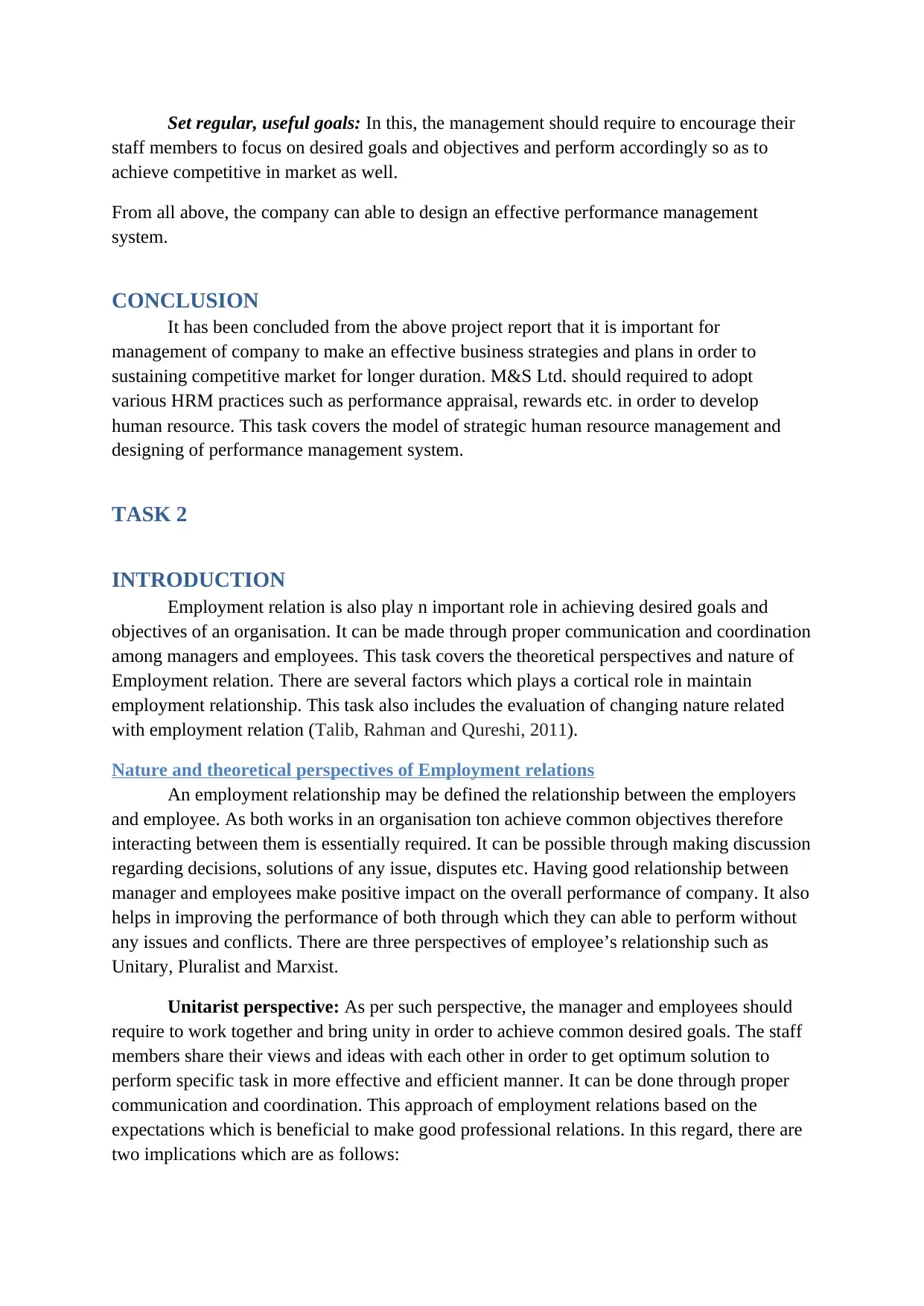
Set regular, useful goals: In this, the management should require to encourage their
staff members to focus on desired goals and objectives and perform accordingly so as to
achieve competitive in market as well.
From all above, the company can able to design an effective performance management
system.
CONCLUSION
It has been concluded from the above project report that it is important for
management of company to make an effective business strategies and plans in order to
sustaining competitive market for longer duration. M&S Ltd. should required to adopt
various HRM practices such as performance appraisal, rewards etc. in order to develop
human resource. This task covers the model of strategic human resource management and
designing of performance management system.
TASK 2
INTRODUCTION
Employment relation is also play n important role in achieving desired goals and
objectives of an organisation. It can be made through proper communication and coordination
among managers and employees. This task covers the theoretical perspectives and nature of
Employment relation. There are several factors which plays a cortical role in maintain
employment relationship. This task also includes the evaluation of changing nature related
with employment relation (Talib, Rahman and Qureshi, 2011).
Nature and theoretical perspectives of Employment relations
An employment relationship may be defined the relationship between the employers
and employee. As both works in an organisation ton achieve common objectives therefore
interacting between them is essentially required. It can be possible through making discussion
regarding decisions, solutions of any issue, disputes etc. Having good relationship between
manager and employees make positive impact on the overall performance of company. It also
helps in improving the performance of both through which they can able to perform without
any issues and conflicts. There are three perspectives of employee’s relationship such as
Unitary, Pluralist and Marxist.
Unitarist perspective: As per such perspective, the manager and employees should
require to work together and bring unity in order to achieve common desired goals. The staff
members share their views and ideas with each other in order to get optimum solution to
perform specific task in more effective and efficient manner. It can be done through proper
communication and coordination. This approach of employment relations based on the
expectations which is beneficial to make good professional relations. In this regard, there are
two implications which are as follows:
staff members to focus on desired goals and objectives and perform accordingly so as to
achieve competitive in market as well.
From all above, the company can able to design an effective performance management
system.
CONCLUSION
It has been concluded from the above project report that it is important for
management of company to make an effective business strategies and plans in order to
sustaining competitive market for longer duration. M&S Ltd. should required to adopt
various HRM practices such as performance appraisal, rewards etc. in order to develop
human resource. This task covers the model of strategic human resource management and
designing of performance management system.
TASK 2
INTRODUCTION
Employment relation is also play n important role in achieving desired goals and
objectives of an organisation. It can be made through proper communication and coordination
among managers and employees. This task covers the theoretical perspectives and nature of
Employment relation. There are several factors which plays a cortical role in maintain
employment relationship. This task also includes the evaluation of changing nature related
with employment relation (Talib, Rahman and Qureshi, 2011).
Nature and theoretical perspectives of Employment relations
An employment relationship may be defined the relationship between the employers
and employee. As both works in an organisation ton achieve common objectives therefore
interacting between them is essentially required. It can be possible through making discussion
regarding decisions, solutions of any issue, disputes etc. Having good relationship between
manager and employees make positive impact on the overall performance of company. It also
helps in improving the performance of both through which they can able to perform without
any issues and conflicts. There are three perspectives of employee’s relationship such as
Unitary, Pluralist and Marxist.
Unitarist perspective: As per such perspective, the manager and employees should
require to work together and bring unity in order to achieve common desired goals. The staff
members share their views and ideas with each other in order to get optimum solution to
perform specific task in more effective and efficient manner. It can be done through proper
communication and coordination. This approach of employment relations based on the
expectations which is beneficial to make good professional relations. In this regard, there are
two implications which are as follows:
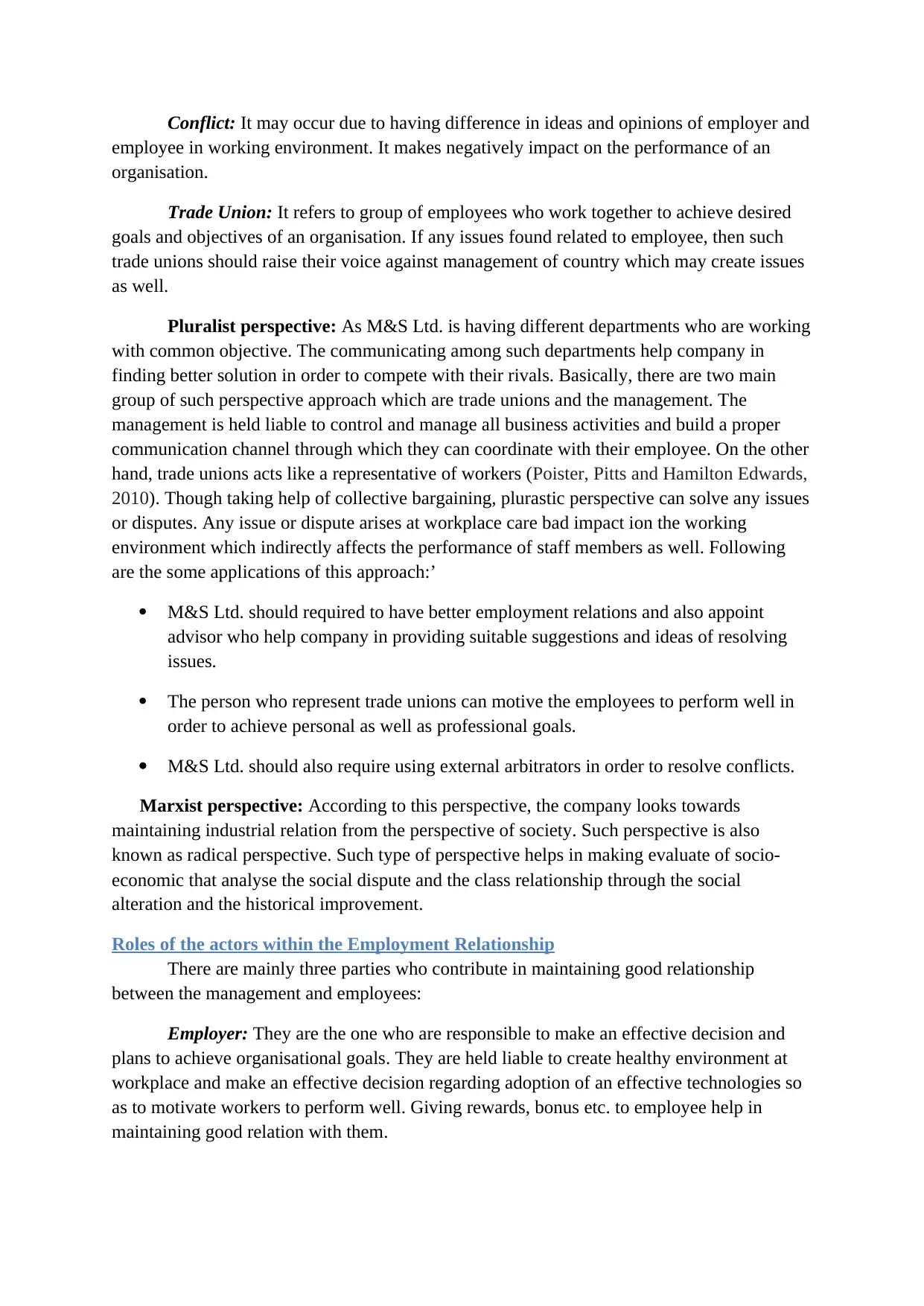
Conflict: It may occur due to having difference in ideas and opinions of employer and
employee in working environment. It makes negatively impact on the performance of an
organisation.
Trade Union: It refers to group of employees who work together to achieve desired
goals and objectives of an organisation. If any issues found related to employee, then such
trade unions should raise their voice against management of country which may create issues
as well.
Pluralist perspective: As M&S Ltd. is having different departments who are working
with common objective. The communicating among such departments help company in
finding better solution in order to compete with their rivals. Basically, there are two main
group of such perspective approach which are trade unions and the management. The
management is held liable to control and manage all business activities and build a proper
communication channel through which they can coordinate with their employee. On the other
hand, trade unions acts like a representative of workers (Poister, Pitts and Hamilton Edwards,
2010). Though taking help of collective bargaining, plurastic perspective can solve any issues
or disputes. Any issue or dispute arises at workplace care bad impact ion the working
environment which indirectly affects the performance of staff members as well. Following
are the some applications of this approach:’
M&S Ltd. should required to have better employment relations and also appoint
advisor who help company in providing suitable suggestions and ideas of resolving
issues.
The person who represent trade unions can motive the employees to perform well in
order to achieve personal as well as professional goals.
M&S Ltd. should also require using external arbitrators in order to resolve conflicts.
Marxist perspective: According to this perspective, the company looks towards
maintaining industrial relation from the perspective of society. Such perspective is also
known as radical perspective. Such type of perspective helps in making evaluate of socio-
economic that analyse the social dispute and the class relationship through the social
alteration and the historical improvement.
Roles of the actors within the Employment Relationship
There are mainly three parties who contribute in maintaining good relationship
between the management and employees:
Employer: They are the one who are responsible to make an effective decision and
plans to achieve organisational goals. They are held liable to create healthy environment at
workplace and make an effective decision regarding adoption of an effective technologies so
as to motivate workers to perform well. Giving rewards, bonus etc. to employee help in
maintaining good relation with them.
employee in working environment. It makes negatively impact on the performance of an
organisation.
Trade Union: It refers to group of employees who work together to achieve desired
goals and objectives of an organisation. If any issues found related to employee, then such
trade unions should raise their voice against management of country which may create issues
as well.
Pluralist perspective: As M&S Ltd. is having different departments who are working
with common objective. The communicating among such departments help company in
finding better solution in order to compete with their rivals. Basically, there are two main
group of such perspective approach which are trade unions and the management. The
management is held liable to control and manage all business activities and build a proper
communication channel through which they can coordinate with their employee. On the other
hand, trade unions acts like a representative of workers (Poister, Pitts and Hamilton Edwards,
2010). Though taking help of collective bargaining, plurastic perspective can solve any issues
or disputes. Any issue or dispute arises at workplace care bad impact ion the working
environment which indirectly affects the performance of staff members as well. Following
are the some applications of this approach:’
M&S Ltd. should required to have better employment relations and also appoint
advisor who help company in providing suitable suggestions and ideas of resolving
issues.
The person who represent trade unions can motive the employees to perform well in
order to achieve personal as well as professional goals.
M&S Ltd. should also require using external arbitrators in order to resolve conflicts.
Marxist perspective: According to this perspective, the company looks towards
maintaining industrial relation from the perspective of society. Such perspective is also
known as radical perspective. Such type of perspective helps in making evaluate of socio-
economic that analyse the social dispute and the class relationship through the social
alteration and the historical improvement.
Roles of the actors within the Employment Relationship
There are mainly three parties who contribute in maintaining good relationship
between the management and employees:
Employer: They are the one who are responsible to make an effective decision and
plans to achieve organisational goals. They are held liable to create healthy environment at
workplace and make an effective decision regarding adoption of an effective technologies so
as to motivate workers to perform well. Giving rewards, bonus etc. to employee help in
maintaining good relation with them.
⊘ This is a preview!⊘
Do you want full access?
Subscribe today to unlock all pages.

Trusted by 1+ million students worldwide
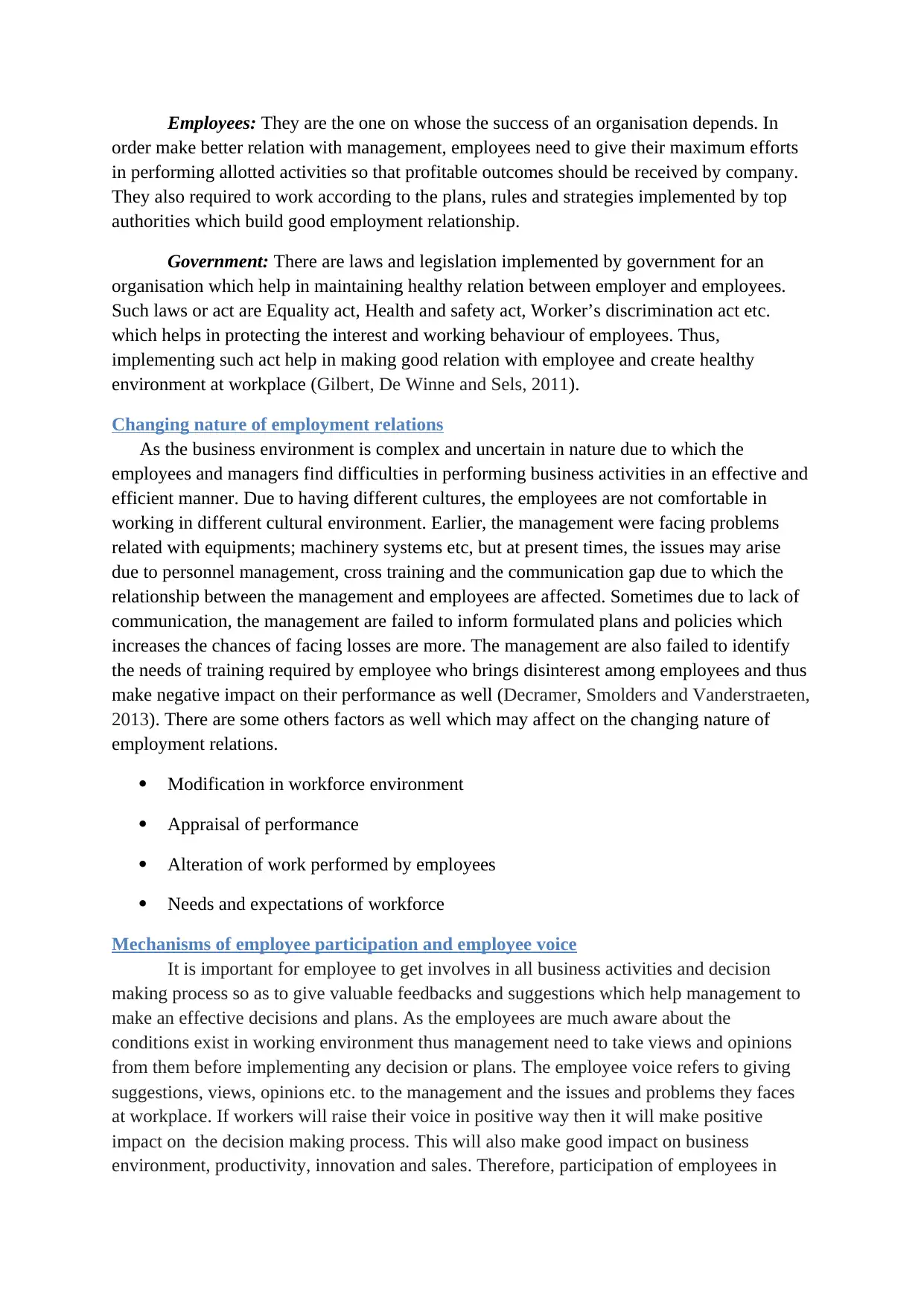
Employees: They are the one on whose the success of an organisation depends. In
order make better relation with management, employees need to give their maximum efforts
in performing allotted activities so that profitable outcomes should be received by company.
They also required to work according to the plans, rules and strategies implemented by top
authorities which build good employment relationship.
Government: There are laws and legislation implemented by government for an
organisation which help in maintaining healthy relation between employer and employees.
Such laws or act are Equality act, Health and safety act, Worker’s discrimination act etc.
which helps in protecting the interest and working behaviour of employees. Thus,
implementing such act help in making good relation with employee and create healthy
environment at workplace (Gilbert, De Winne and Sels, 2011).
Changing nature of employment relations
As the business environment is complex and uncertain in nature due to which the
employees and managers find difficulties in performing business activities in an effective and
efficient manner. Due to having different cultures, the employees are not comfortable in
working in different cultural environment. Earlier, the management were facing problems
related with equipments; machinery systems etc, but at present times, the issues may arise
due to personnel management, cross training and the communication gap due to which the
relationship between the management and employees are affected. Sometimes due to lack of
communication, the management are failed to inform formulated plans and policies which
increases the chances of facing losses are more. The management are also failed to identify
the needs of training required by employee who brings disinterest among employees and thus
make negative impact on their performance as well (Decramer, Smolders and Vanderstraeten,
2013). There are some others factors as well which may affect on the changing nature of
employment relations.
Modification in workforce environment
Appraisal of performance
Alteration of work performed by employees
Needs and expectations of workforce
Mechanisms of employee participation and employee voice
It is important for employee to get involves in all business activities and decision
making process so as to give valuable feedbacks and suggestions which help management to
make an effective decisions and plans. As the employees are much aware about the
conditions exist in working environment thus management need to take views and opinions
from them before implementing any decision or plans. The employee voice refers to giving
suggestions, views, opinions etc. to the management and the issues and problems they faces
at workplace. If workers will raise their voice in positive way then it will make positive
impact on the decision making process. This will also make good impact on business
environment, productivity, innovation and sales. Therefore, participation of employees in
order make better relation with management, employees need to give their maximum efforts
in performing allotted activities so that profitable outcomes should be received by company.
They also required to work according to the plans, rules and strategies implemented by top
authorities which build good employment relationship.
Government: There are laws and legislation implemented by government for an
organisation which help in maintaining healthy relation between employer and employees.
Such laws or act are Equality act, Health and safety act, Worker’s discrimination act etc.
which helps in protecting the interest and working behaviour of employees. Thus,
implementing such act help in making good relation with employee and create healthy
environment at workplace (Gilbert, De Winne and Sels, 2011).
Changing nature of employment relations
As the business environment is complex and uncertain in nature due to which the
employees and managers find difficulties in performing business activities in an effective and
efficient manner. Due to having different cultures, the employees are not comfortable in
working in different cultural environment. Earlier, the management were facing problems
related with equipments; machinery systems etc, but at present times, the issues may arise
due to personnel management, cross training and the communication gap due to which the
relationship between the management and employees are affected. Sometimes due to lack of
communication, the management are failed to inform formulated plans and policies which
increases the chances of facing losses are more. The management are also failed to identify
the needs of training required by employee who brings disinterest among employees and thus
make negative impact on their performance as well (Decramer, Smolders and Vanderstraeten,
2013). There are some others factors as well which may affect on the changing nature of
employment relations.
Modification in workforce environment
Appraisal of performance
Alteration of work performed by employees
Needs and expectations of workforce
Mechanisms of employee participation and employee voice
It is important for employee to get involves in all business activities and decision
making process so as to give valuable feedbacks and suggestions which help management to
make an effective decisions and plans. As the employees are much aware about the
conditions exist in working environment thus management need to take views and opinions
from them before implementing any decision or plans. The employee voice refers to giving
suggestions, views, opinions etc. to the management and the issues and problems they faces
at workplace. If workers will raise their voice in positive way then it will make positive
impact on the decision making process. This will also make good impact on business
environment, productivity, innovation and sales. Therefore, participation of employees in
Paraphrase This Document
Need a fresh take? Get an instant paraphrase of this document with our AI Paraphraser
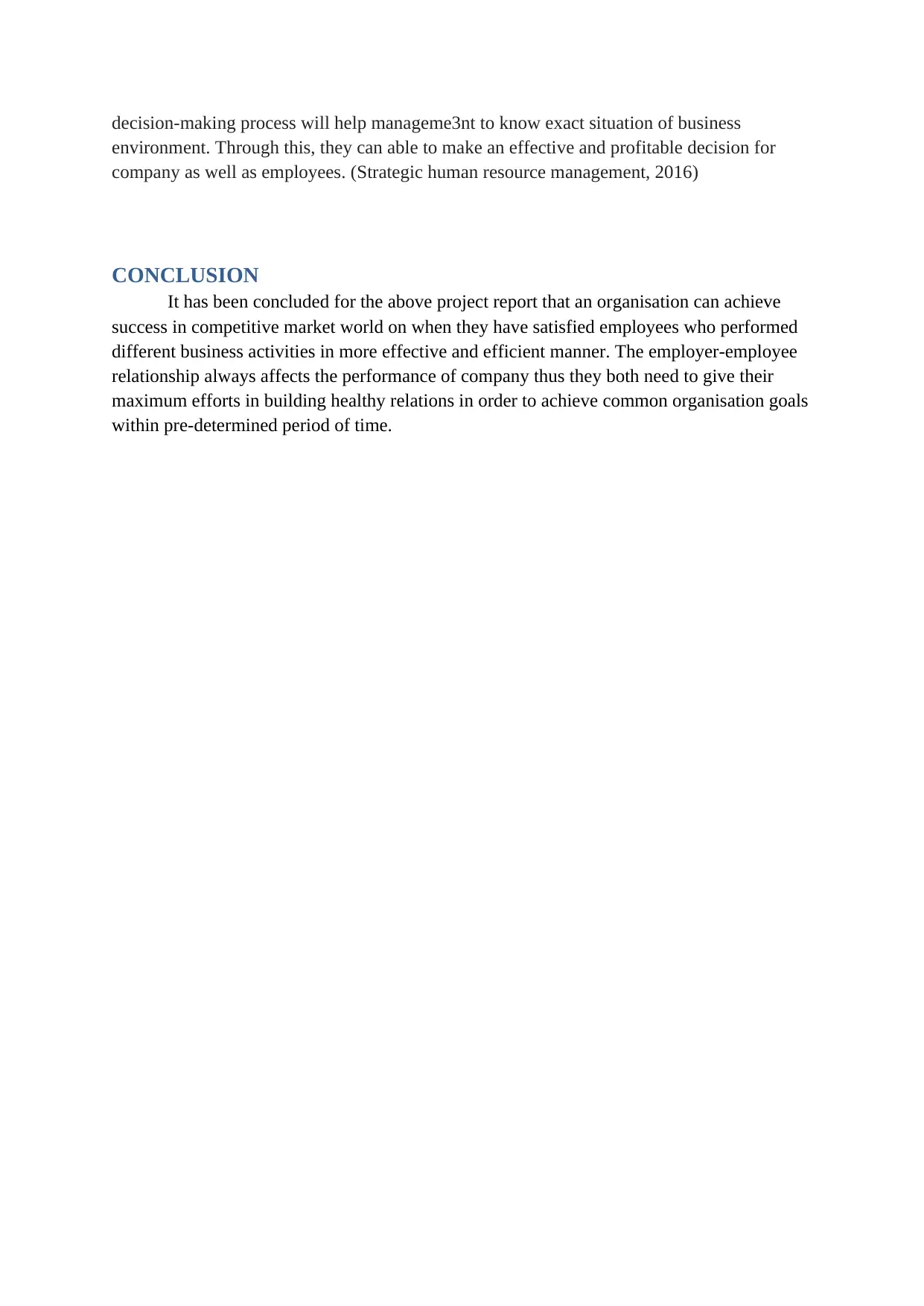
decision-making process will help manageme3nt to know exact situation of business
environment. Through this, they can able to make an effective and profitable decision for
company as well as employees. (Strategic human resource management, 2016)
CONCLUSION
It has been concluded for the above project report that an organisation can achieve
success in competitive market world on when they have satisfied employees who performed
different business activities in more effective and efficient manner. The employer-employee
relationship always affects the performance of company thus they both need to give their
maximum efforts in building healthy relations in order to achieve common organisation goals
within pre-determined period of time.
environment. Through this, they can able to make an effective and profitable decision for
company as well as employees. (Strategic human resource management, 2016)
CONCLUSION
It has been concluded for the above project report that an organisation can achieve
success in competitive market world on when they have satisfied employees who performed
different business activities in more effective and efficient manner. The employer-employee
relationship always affects the performance of company thus they both need to give their
maximum efforts in building healthy relations in order to achieve common organisation goals
within pre-determined period of time.
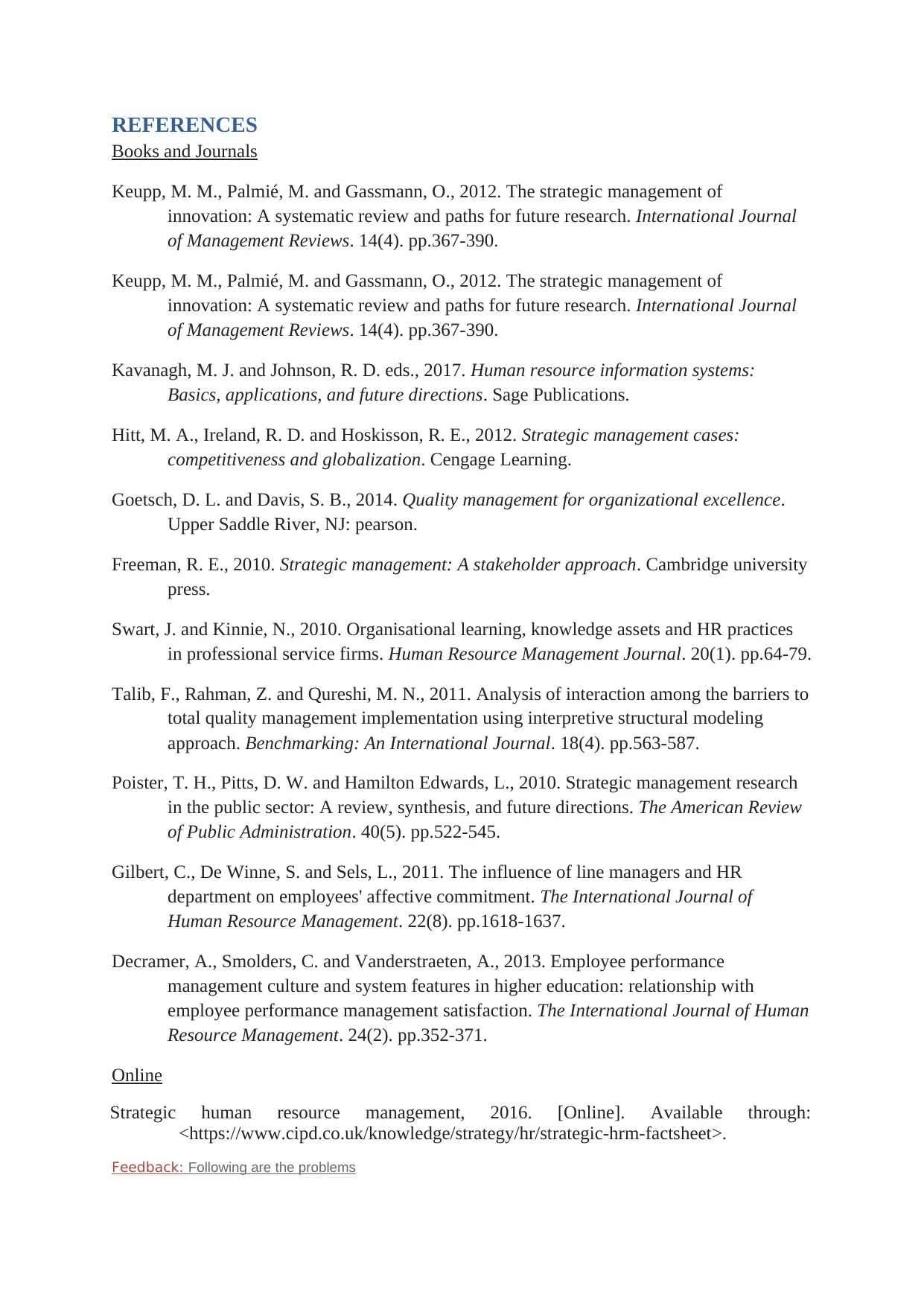
REFERENCES
Books and Journals
Keupp, M. M., Palmié, M. and Gassmann, O., 2012. The strategic management of
innovation: A systematic review and paths for future research. International Journal
of Management Reviews. 14(4). pp.367-390.
Keupp, M. M., Palmié, M. and Gassmann, O., 2012. The strategic management of
innovation: A systematic review and paths for future research. International Journal
of Management Reviews. 14(4). pp.367-390.
Kavanagh, M. J. and Johnson, R. D. eds., 2017. Human resource information systems:
Basics, applications, and future directions. Sage Publications.
Hitt, M. A., Ireland, R. D. and Hoskisson, R. E., 2012. Strategic management cases:
competitiveness and globalization. Cengage Learning.
Goetsch, D. L. and Davis, S. B., 2014. Quality management for organizational excellence.
Upper Saddle River, NJ: pearson.
Freeman, R. E., 2010. Strategic management: A stakeholder approach. Cambridge university
press.
Swart, J. and Kinnie, N., 2010. Organisational learning, knowledge assets and HR practices
in professional service firms. Human Resource Management Journal. 20(1). pp.64-79.
Talib, F., Rahman, Z. and Qureshi, M. N., 2011. Analysis of interaction among the barriers to
total quality management implementation using interpretive structural modeling
approach. Benchmarking: An International Journal. 18(4). pp.563-587.
Poister, T. H., Pitts, D. W. and Hamilton Edwards, L., 2010. Strategic management research
in the public sector: A review, synthesis, and future directions. The American Review
of Public Administration. 40(5). pp.522-545.
Gilbert, C., De Winne, S. and Sels, L., 2011. The influence of line managers and HR
department on employees' affective commitment. The International Journal of
Human Resource Management. 22(8). pp.1618-1637.
Decramer, A., Smolders, C. and Vanderstraeten, A., 2013. Employee performance
management culture and system features in higher education: relationship with
employee performance management satisfaction. The International Journal of Human
Resource Management. 24(2). pp.352-371.
Online
Strategic human resource management, 2016. [Online]. Available through:
<https://www.cipd.co.uk/knowledge/strategy/hr/strategic-hrm-factsheet>.
Feedback: Following are the problems
Books and Journals
Keupp, M. M., Palmié, M. and Gassmann, O., 2012. The strategic management of
innovation: A systematic review and paths for future research. International Journal
of Management Reviews. 14(4). pp.367-390.
Keupp, M. M., Palmié, M. and Gassmann, O., 2012. The strategic management of
innovation: A systematic review and paths for future research. International Journal
of Management Reviews. 14(4). pp.367-390.
Kavanagh, M. J. and Johnson, R. D. eds., 2017. Human resource information systems:
Basics, applications, and future directions. Sage Publications.
Hitt, M. A., Ireland, R. D. and Hoskisson, R. E., 2012. Strategic management cases:
competitiveness and globalization. Cengage Learning.
Goetsch, D. L. and Davis, S. B., 2014. Quality management for organizational excellence.
Upper Saddle River, NJ: pearson.
Freeman, R. E., 2010. Strategic management: A stakeholder approach. Cambridge university
press.
Swart, J. and Kinnie, N., 2010. Organisational learning, knowledge assets and HR practices
in professional service firms. Human Resource Management Journal. 20(1). pp.64-79.
Talib, F., Rahman, Z. and Qureshi, M. N., 2011. Analysis of interaction among the barriers to
total quality management implementation using interpretive structural modeling
approach. Benchmarking: An International Journal. 18(4). pp.563-587.
Poister, T. H., Pitts, D. W. and Hamilton Edwards, L., 2010. Strategic management research
in the public sector: A review, synthesis, and future directions. The American Review
of Public Administration. 40(5). pp.522-545.
Gilbert, C., De Winne, S. and Sels, L., 2011. The influence of line managers and HR
department on employees' affective commitment. The International Journal of
Human Resource Management. 22(8). pp.1618-1637.
Decramer, A., Smolders, C. and Vanderstraeten, A., 2013. Employee performance
management culture and system features in higher education: relationship with
employee performance management satisfaction. The International Journal of Human
Resource Management. 24(2). pp.352-371.
Online
Strategic human resource management, 2016. [Online]. Available through:
<https://www.cipd.co.uk/knowledge/strategy/hr/strategic-hrm-factsheet>.
Feedback: Following are the problems
⊘ This is a preview!⊘
Do you want full access?
Subscribe today to unlock all pages.

Trusted by 1+ million students worldwide
1 out of 15
Related Documents
Your All-in-One AI-Powered Toolkit for Academic Success.
+13062052269
info@desklib.com
Available 24*7 on WhatsApp / Email
![[object Object]](/_next/static/media/star-bottom.7253800d.svg)
Unlock your academic potential
Copyright © 2020–2025 A2Z Services. All Rights Reserved. Developed and managed by ZUCOL.





